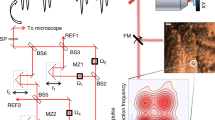Abstract
Two-dimensional fluorescence spectroscopy (2D-FS) has been used as a new method for determining the viability of tobacco cells (Nicotiana tabacum L.). Both horizontal beam geometry and a vertical set-up achieved with bifurcated fibres were tested. The latter arrangement enabled us to avoid the negative effect of cell sedimentation. Incubation of a tobacco BY-2 cell suspension with dimethylsulfoxide (DMSO) (0–10% v/v) resulted in cell samples differing in their viability – from fully viable (0–2% DMSO) to totally non-viable (8–10%DMSO). The validity of determining viability by means of measuring cell esterase activity by 2D-FS using fluorescein diacetate as a fluorogenic substrate was verified by comparison with microscopic evaluation of fluorescein fluorescence as well as with the routinely adopted trypan blue exclusion test.
Similar content being viewed by others
Author information
Authors and Affiliations
Additional information
Received: 6 June 2000 / Revision received: 9 October 2000 / Accepted: 9 October 2000
Rights and permissions
About this article
Cite this article
Vaňková, R., Kuncová, G., Opatrná, J. et al. Two-dimensional fluorescence spectroscopy – a new tool for the determination of plant cell viability. Plant Cell Reports 20, 41–47 (2001). https://doi.org/10.1007/s002990000294
Issue Date:
DOI: https://doi.org/10.1007/s002990000294




